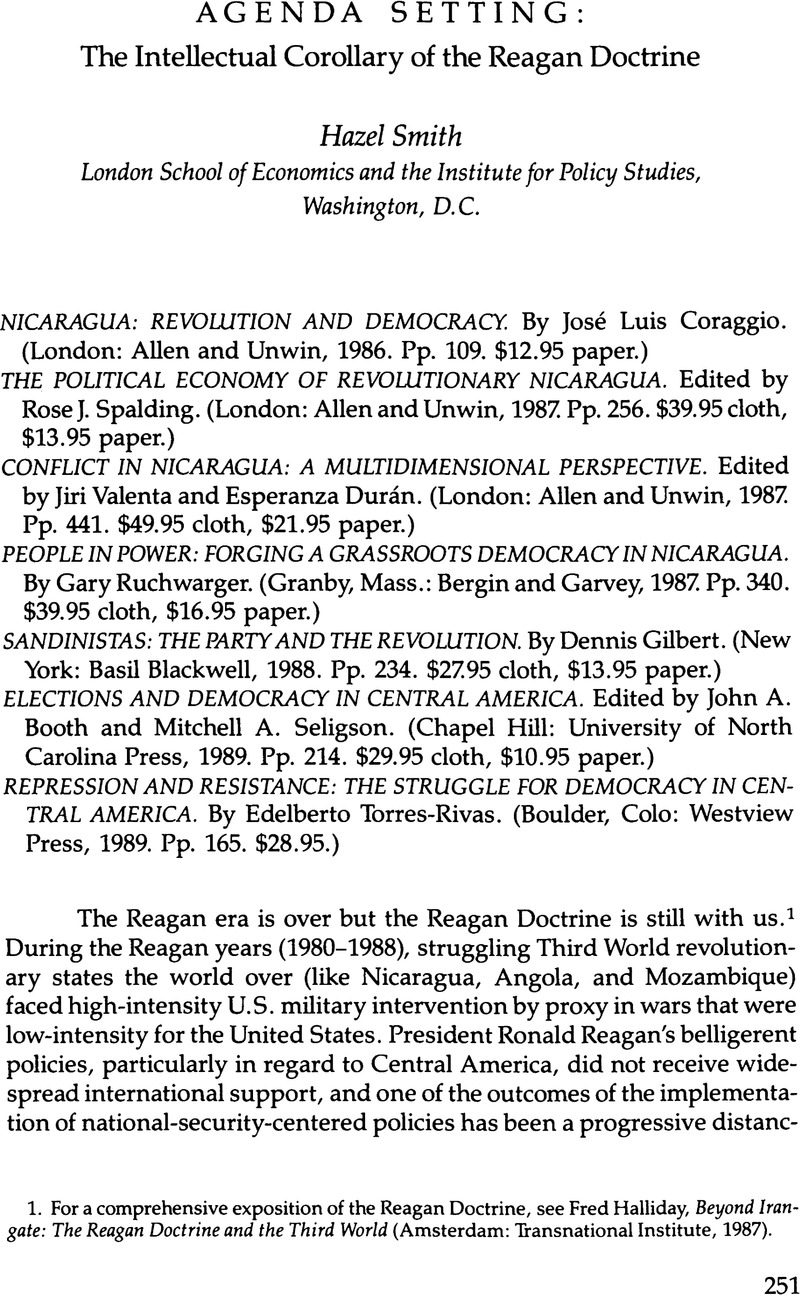Article contents
Agenda Setting: The Intellectual Corollary of the Reagan Doctrine
Review products
Published online by Cambridge University Press: 12 October 2022
Abstract

- Type
- Review Essays
- Information
- Copyright
- Copyright © 1991 by the University of Texas Press
References
Notes
1. For a comprehensive exposition of the Reagan Doctrine, see Fred Halliday, Beyond Irangate: The Reagan Doctrine and the Third World (Amsterdam: Transnational Institute, 1987).
2. See Daniel Siegel and Tom Spaulding with Peter Kornbluh, Outcast among Allies (Washington, D.C.: Institute for Policy Studies, 1985).
3. Committee of Santa Fe, A New Inter-American Policy for the Eighties (Washington, D.C.: Council for Inter-American Security, 1980). For a critique of the premises, see Richard R. Fagen, “United States Policy in Central America,” Millennium (London) 13, no. 2 (Summer 1984):105–15.
4. On 21 Feb. 1985 at a televised press briefing, President Reagan stated that the United States wished to remove the “present structure” of the Nicaraguan government.
5. See the Kissinger Commission report, Report of the National Bipartisan Commission on Central America (Washington, D.C.: U.S. Government Printing Office, 1984). For a useful critique, see Aníbal Romero, “The Kissinger Report and the Restoration of Hegemony,” Millennium 13, no. 2 (Summer 1984):116–28. To cite one example, “The picture the report draws of the Sandinista movement is that of a dogmatic Marxist-Leninist organization, paying no attention to the complexity of the Sandinista Movement's social composition and the diversity of its ideological strands. The conclusion is inescapable: given the nature of the enemy, the only alternative is to eliminate it” (p. 125).
6. See Vernon V. Asparturian's comment, “The elements of deceit and duplicity in the consolidation of Sandinista power are more evident and perhaps necessary for success than in Cuba” (Valenta and Durán, p. 214).
7. See, for example, José Luis Coraggio and George Irvin, “Revolution and Pluralism in Nicaragua,” Millennium 13, no. 2 (Summer 1984):194–204; and Roger Burbach and Orlando Núñez, Fire in the Americas: Forging a Revolutionary Agenda (London and New York: Verso, 1987).
8. For instance, see Coraggio's statement on the relationship between single-issue social movements and the political parties: “the Sandinista Peoples' revolution attempted to seek a provisional form for a process that has still to be resolved in Europe: the articulation between political parties and social movements” (p. 38).
9. Antoni Kapcia argues that pluralism is inherent in Sandinismo because the FSLN came together from three separate political currents, an obviously partial analysis. See Kapcia, “What is Sandinismo?” paper presented at the conference “Puebla y Cultura,” 1984, at All Saints College, Leeds, England.
10. Coraggio and Irvin assert, “The fundamental objective of the revolution is not to consolidate power in the hands of the state; rather it is to transform civil society, creating an autonomous institutional base for the majority from which the state derives its legitimacy, and from which political power is mandated.” See Coraggio and Irvin, “Revolution and Pluralism in Nicaragua,” 201.
11. For a West European journalist's account of the Nicaraguan elections of 1984 that includes election results by party, see Carlos Ferrari López, “Des elections, pour quoi faire?” in Editions la découverte: Le Volcan nicaraguayen, edited by Marie Duflo and Françoise Ruellan (Paris: La Découverte, 1985). According to Ferrari López, “The numerous foreign observers who oversaw the voting and afterward the counting of the votes verified that voting procedures were in order. The accusations of fraud from La Prensa did not convince the most skeptical observers. The voters had been able to approach the voting booths, often discovering to their surprise the ongoing ritual of a Western-style election.”
12. Coraggio and Irvin, “Revolution and Pluralism in Nicaragua,” 194.
13. Memorandum to the President, 1 May 1952, in Foreign Relations of the United States, 1952–1954, 4:1369–70. From an excerpt published in The Central American Crisis Reader, edited by Robert S. Leiken and Barry Rubin (New York: Summit Books, 1987), 96.
14. Cultural relativism claims that values differ according to the society studied, making it difficult to attempt comparative analysis and almost impossible to develop general conceptual categories on issues like democracy. In another context, Philip Windsor has referred to “the intellectual vacuity of cultural relativism.” See Windsor, “Women and International Relations: What's the Problem?” Millennium 17, no. 3 (Winter 1988):458.
15. On the question of the Sandinista decision to wait until 1984 to hold the elections, Coraggio and Irvin have pointed out, “The decision taken by the Sandinistas in 1980 to hold elections in five years time was not tactical; if anything ‘tactics’ would have called for holding immediate elections. It was instead a decision of principle which argued that, until ordinary people had been given the opportunity to build their own representative institutions and participatory practices within civil society, most particularly in the workplace and in the community, they would have little effective weight within the formal political institutions of the state.” See Coraggio and Irvin, “Revolution and Pluralism in Nicaragua,” 198.
16. According to Enriquez and Spalding, “The contradiction between the broad development objectives of the Sandinista government and the nations' profound resource limitations, and between the government's aspirations and its realm of control, remain central problems of the Nicaraguan revolution” (p. 125).
17. See Hazel Smith, “Race and Class in Revolutionary Nicaragua: Autonomy and the Atlantic Coast,” Institute of Development Studies (IDS) Bulletin 19, no. 3 (July 1988):66–72.
18. According to Hobsbawm, “‘Revolution’ and ‘counterrevolution’ may share much of the same analysis. … The two terms are not simply opposed … but dialectically related.” See E. J. Hobsbawm, “Revolution, ” in Revolution in History, edited by Roy Porter and Mikulás Teich (Cambridge: Cambridge University Press, 1986), 11.
- 1
- Cited by




